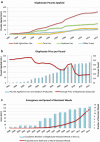Trends in glyphosate herbicide use in the United States and globally
- PMID: 27752438
- PMCID: PMC5044953
- DOI: 10.1186/s12302-016-0070-0
Trends in glyphosate herbicide use in the United States and globally
Abstract
Background: Accurate pesticide use data are essential when studying the environmental and public health impacts of pesticide use. Since the mid-1990s, significant changes have occurred in when and how glyphosate herbicides are applied, and there has been a dramatic increase in the total volume applied.
Methods: Data on glyphosate applications were collected from multiple sources and integrated into a dataset spanning agricultural, non-agricultural, and total glyphosate use from 1974-2014 in the United States, and from 1994-2014 globally.
Results: Since 1974 in the U.S., over 1.6 billion kilograms of glyphosate active ingredient have been applied, or 19 % of estimated global use of glyphosate (8.6 billion kilograms). Globally, glyphosate use has risen almost 15-fold since so-called "Roundup Ready," genetically engineered glyphosate-tolerant crops were introduced in 1996. Two-thirds of the total volume of glyphosate applied in the U.S. from 1974 to 2014 has been sprayed in just the last 10 years. The corresponding share globally is 72 %. In 2014, farmers sprayed enough glyphosate to apply ~1.0 kg/ha (0.8 pound/acre) on every hectare of U.S.-cultivated cropland and nearly 0.53 kg/ha (0.47 pounds/acre) on all cropland worldwide.
Conclusions: Genetically engineered herbicide-tolerant crops now account for about 56 % of global glyphosate use. In the U.S., no pesticide has come remotely close to such intensive and widespread use. This is likely the case globally, but published global pesticide use data are sparse. Glyphosate will likely remain the most widely applied pesticide worldwide for years to come, and interest will grow in quantifying ecological and human health impacts. Accurate, accessible time-series data on glyphosate use will accelerate research progress.
Keywords: Genetic engineering; Glyphosate; Herbicide use; Herbicide-tolerant crops; Pesticide use; Roundup.
Figures
References
-
- Dill GM, Sammons RD, Feng PCC, Kohn F, Kretzmer K, Mehrsheikh A, Bleeke M, Honegger JL, Farmer D, Wright D, Haupfear EA. Glyphosate: discovery, development, applications, and properties. Chapter 1. In: Nandula VK, editor. Glyphosate resistance in crops and weeds: history, development, and management. New York: Wiley; 2010. pp. 1–33.
-
- Monsanto Company. “Genuity Roundup Ready Sugarbeets,”. 2015. http://www.monsanto.com/newsviews/pages/genuity-roundup-ready-sugarbeets.... Accessed 9 Aug 2015
-
- Monsanto Company. “Lawsuit Involving Roundup Ready Alfalfa,”. 2015. http://www.monsanto.com/newsviews/pages/roundup-ready-alfalfa-supreme-co.... Accessed 9 Aug 2015
LinkOut - more resources
Full Text Sources
Other Literature Sources




